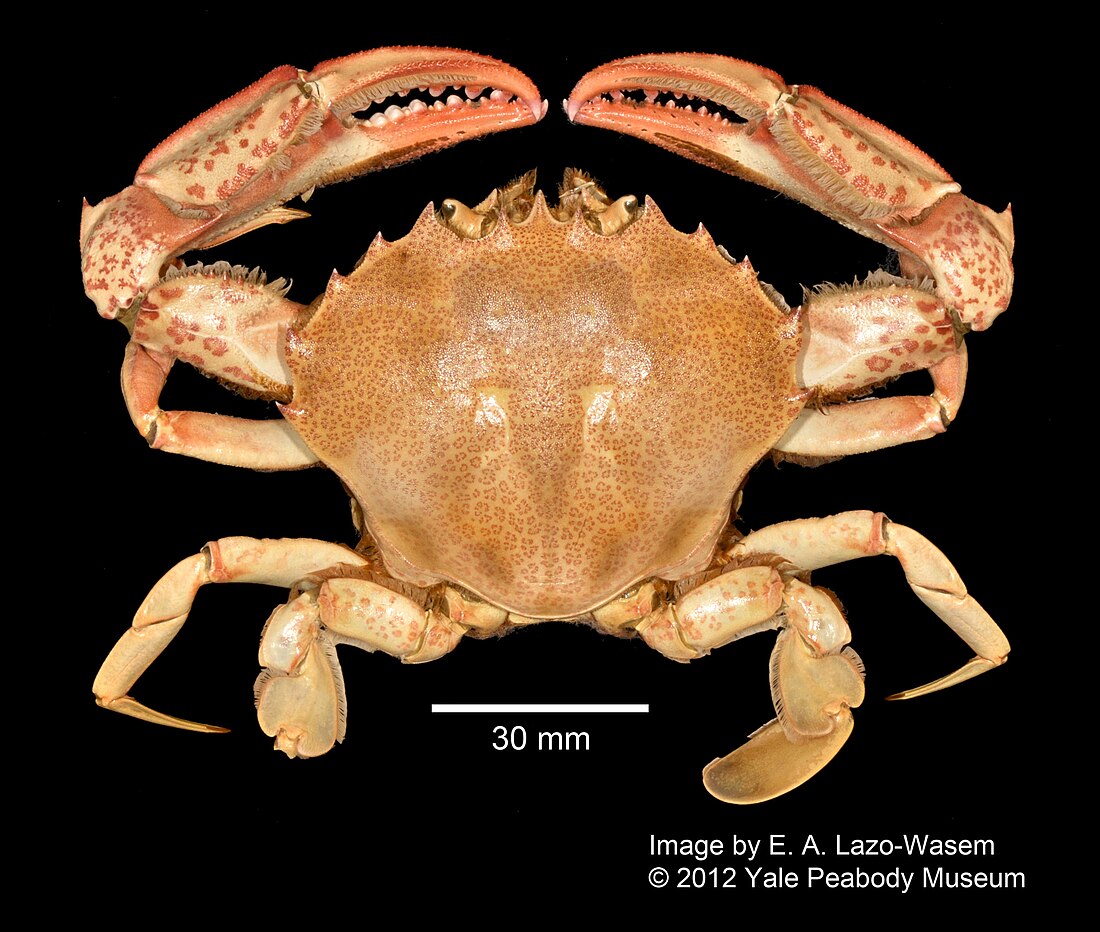Top Qs
Timeline
Chat
Perspective
Ovalipes ocellatus
Species of crab From Wikipedia, the free encyclopedia
Remove ads
Ovalipes ocellatus, commonly known as the lady crab,[a] oscellated crab,[b] or calico crab,[6][c] is a species of crab in the family Ovalipidae.[2][8]
Remove ads
Description
The carapace of O. ocellatus is slightly wider than long, at 8.9 centimetres (3.5 in) wide,[6] and 7.5 cm (3.0 in) long.[9] The carapace is yellow-grey[9] or light purplish,[6] with "leopardlike clusters of purple dots".[9] It exhibits a limited iridescence as a form of signalling.[10]
Taxonomy
Summarize
Perspective
Ovalipes ocellatus is commonly known as the lady crab,[a] oscellated crab,[b] or calico crab.[6] It was first described in 1799 by naturalist Johann Friedrich Wilhelm Herbst, who placed it into the genus Cancer.[1][2] In 1898, carcinologist Mary Jane Rathbun moved the species to her new genus Ovalipes.[11] O. ocellatus is part of a distinct group of Ovalipes which also includes O. floridanus, O. iridescens, O. molleri, and O. stephensoni.[12][10][d] O. ocellatus is almost identical to O. floridanus, which lives in the Gulf of Mexico, but can be separated from the sympatric O. stephensoni by purple spots which O. stephensoni lacks.[9] The following cladogram based on morphology shows the relationship between O. catharus and the other extant species of Ovalipes:[10][e]
| Ovalipes |
| |||||||||||||||||||||||||||||||||||||||||||||||||||||||||
Remove ads
Distribution
The distribution of Ovalipes ocellatus extends along North America's Atlantic coast from Canada to Georgia.[9] O. ocellatus is "probably the only Ovalipes species common north of Virginia", being replaced by Ovalipes stephensoni to the south.[14]
Diet
The diet of Ovalipes ocellatus consists predominantly of bivalves, crustaceans including other crabs, polychaetes, cephalopods, and gastropods.[15][16] It rarely feeds on fish.[15]
Life cycle
Ovalipes ocellatus has five zoeal (larval) stages, lasting a total of 18 days at 25 °C (77 °F) and a salinity of 30‰, and 26 days at 20 °C (68 °F) and 30‰.[17]
Ecology

Ovalipes ocellatus is nocturnal and often buries itself in the sand.[6][9] It has been described as "vicious" and "the crab most likely to pinch a wader's toes".[9]
Notes
- Sometimes "ocellate lady crab"[5]
- The nickname "calico crab" is shared with Hepatus epheliticus.[7]
- Ovalipes itself sits within the monogeneric family Ovalipidae.[8]
Remove ads
References
External links
Wikiwand - on
Seamless Wikipedia browsing. On steroids.
Remove ads

